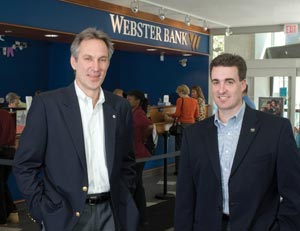|
Cross-selling banking and insurance products Webster Financial builds elite sales teams made up of players from both sides of the enterprisek By Thomas A. McCoy
In 1998 Webster Financial Corporation, which operates a bank with branches throughout southern New England, acquired Damman Insurance, a Connecticut-based property/casualty agency with 40 employees and $7 million in revenues. It was the first of eight agency acquisitions Webster was to make over the next five years. Today Webster Insurance, operating as a subsidiary of the banking organization, is the largest agency in Connecticut. When Webster acquired Damman Insurance in 1998, 2% of the bank’s commercial mid-market customers were insurance customers of the acquired agency. Today 18% of the bank’s commercial mid-market clients are customers of Webster Insurance. That cross-selling success didn’t happen overnight, although there were hopes at first that it would. The Damman Insurance people, influenced by the allure of working for a bank with branches all over the state, jumped at the chance to pull bank customers into the agency fold. John Klecha, executive vice president of Webster Insurance and a partner in Damman Insurance at the time of the initial acquisition, describes the early efforts. “We furnished the bank branches with a tool kit made up of some product briefs and a referral form that they could fax to us. Within two months we had about 6,000 insurance leads, but it wasn’t the kind of business we were interested in writing.” The agency’s business was about 60% mid-market commercial lines, 20% personal lines, and 20% employee benefits. “The referrals we got were mostly personal lines that didn’t match our targets,” says Klecha. “At that time the cross referral laws were arcane,” he explains. “We had to pay the bank branch people for all referrals, whether it was successfully sold or not, so they were sending us just about anything. We decided to give up this effort.” Klecha and the other agency executives decided to spend some time getting to know the bankers who were now their partners. “We got together with the commercial banking officers for informal breakfast meetings—kind of like a courtship. We’d ask them, ‘How do you produce business? What does the profile of a good customer look like for you? Do you know this person or that person?’” This networking helped to break down some of the inherent barriers to the bankers and agents working together—barriers that were based not only on the differences in their products, but also the disparity in the size of their customer bases. “Because the bank had roughly 25,000 business customers and we had about 4,000 at Damman, the bank people could look at us as having more to gain from cross-selling than they did,” Klecha says. “Fortunately, our senior management has been totally committed to the idea of referring business back and forth.” In 2001 Webster instituted a formalized strategy for cross-selling by setting up sales teams, each made up of six members, including investment officers, banking, and insurance people. Currently there are 18 of these teams, organized by geography or industry specialty. Each team operates under the direction of a mentor, someone who serves in a sales management role for a particular business unit within Webster, and who takes on the additional role of guiding a team in its cross-selling efforts.
Under the mentors, each team includes one representative from each business line: one commercial banker, one small business banker, two insurance representatives—one property/casualty and one benefits/financial services, one personal investment advisor (for high net worth clients), and an investment services representative, (for mid- to lower net worth clients). “We get these people together and they truly act as a team,” says James O’Meara, marketing director, commercial banking of Webster Bank and chief administrative officer for Webster’s Sales Council. “They don’t just review each other’s lists; they can set up events to do together; they go on joint calls, and work on call planning.” About three quarters of the individuals who could potentially be on these teams are, in fact, assigned to a team, O’Meara notes. “And all of them want to be on one. It’s become something of an exclusive club.” The Sales Board, which includes Klecha, O’Meara, and other business line executives, is responsible for putting together the teams, resolving disputes, assigning mentors, adding people to teams and removing people from teams. The establishment of goals is critical to the sales teams because compensation is structured around meeting individual goals and team goals, all designed to stimulate the referral process. O’Meara explains: “A person on the team who refers business to others will be compensated for that referral. Then, if everyone on the team meets his or her individual referral goals, everyone on the team as a whole receives a bonus. All compensation is based on referrals that result in closed business. There is no additional compensation based on the fact that a commercial real estate person, for example, may be able to refer bigger clients than a P&C insurance person. We do vary the goals occasionally for what we call ‘rookie teams’—those that are newly established.” The compensation structure is set up to avoid “double counting,” Klecha points out. “Just because you’ve sold an account in your line of business, it doesn’t go into the Sales Council pot unless it is truly the result of some cross-sold activity. “We expect our producers to meet their regular sales goals,” Klecha emphasizes. “The cross-selling effort is supplementary and incremental to their regular sales goals.” The Sales Council budget is funded via allocations from each business line. In addition to funding events and activities, a pool is created to reward the top performing cross-sell teams. The mentors of each team also have discretionary authority to vary the payments to individual team members based on performance, subject to the approval of the Sales Council Board. Last year’s payouts averaged $12,000 per team, with some making much more. The success of Webster’s team structure depends not just on money, but on pride, “At the quarterly meetings we take the 18 teams and show their results on overhead slides,” O’Meara explains. “But instead of just showing them in one big list in small print, number 1 through number 18, we break them into four slides, so people can see more clearly the names of the good performers and those who are lagging. You don’t want to be on that third or fourth slide. “It’s a competitive group. When we lay out a goal for cross-selling revenue this year, you can bet they’re going to meet it.” Launching the sales teams and fine-tuning the cross-selling program took as much as 90% of John Klecha’s time during its first six months of operation. It continues to consume far more than the 5% of his time that was originally targeted. However, he says, “It’s a lot of fun—lobbying for your own ideas, listening to the perspectives of people throughout the organization, and making the program work.” O’Meara adds that one reason for the success of the cross-selling effort is the attitude of openness among the individuals on the Sales Council’s board. “They are willing to share the good, the bad, and the ugly. For example, if there’s a problem with the Commercial Banking Division, John Klecha will tell me about it.” Webster Financial Corporation operates 153 bank branches. It has doubled in size three times in the last 12 years. Like many banking organizations, Webster sees the potential of cross-selling of insurance and banking products. Unlike some others, however, they are seriously committed to developing that potential. “From the senior management on down, we’re not just advocates of cross-selling,” says Klecha. “We’re zealots about it.” * |
||||
|




